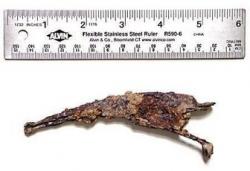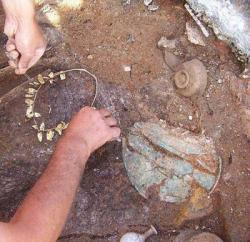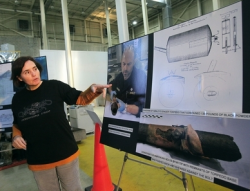INSTITUT SUPERIEUR D'ANTHROPOLOGIE
INSTITUTE OF ANTHROPOLOGY
ONLINE COURSES / COURS A DISTANCE
OPEN COURSE : FEBRUARY 2013
HRM 104 : INTRODUCTION TO INTANGIBLE CULTURAL HERITAGE
REGISTER NOW
USA –  South Berwick - History buffs interested in archaeology have an opportunity this winter to assist Neill De Paoli in processing recently discovered artifacts dating as far back as the mid-1600s. The Old Fields Archaeology Project is named for a neighborhood of South Berwick that 330 years ago was a small hamlet of several homes, a tavern, meetinghouse, burial ground, town wharf and expansive hay fields. Historical documents suggest this locale was a fortified garrison during the conflict-ridden 1690s and early 1700s. The dig site is the former dwelling and tavern of Humphrey and Mary Spencer, who occupied the site from circa 1696 until 1727. This summer, De Paoli will be continuing his search for more evidence of the Spencer home and tavern, along with the as-yet elusive garrison, with the assistance of his crew of volunteers and an archaeological field school.
South Berwick - History buffs interested in archaeology have an opportunity this winter to assist Neill De Paoli in processing recently discovered artifacts dating as far back as the mid-1600s. The Old Fields Archaeology Project is named for a neighborhood of South Berwick that 330 years ago was a small hamlet of several homes, a tavern, meetinghouse, burial ground, town wharf and expansive hay fields. Historical documents suggest this locale was a fortified garrison during the conflict-ridden 1690s and early 1700s. The dig site is the former dwelling and tavern of Humphrey and Mary Spencer, who occupied the site from circa 1696 until 1727. This summer, De Paoli will be continuing his search for more evidence of the Spencer home and tavern, along with the as-yet elusive garrison, with the assistance of his crew of volunteers and an archaeological field school.
http://www.seacoastonline.com/articles/20130128-NEWS-301280318
CHINE – Lingjiatan - Experts from the provincial institute of archaeology have spent over four years investigating Lingjiatan’s sites to ascertain its structure and function. Former archaeological discoveries have provided important clues to reveal the natural and social background of the site. Over 50 pre-Qin ruins of approximately 260 square kilometers were found near the Yuxi River basin, more than 20 of which dated back to the Neolithic Age. Nearly 100 pre-Qin ruins were discovered in more than 400 square kilometers at the Guxi River basin, according to Shuo Zhi, researcher of the provincial institute of archaeology. At present, Shuo is leading a group of archaeological volunteers recruited online to conduct in-depth analysis of results from four years of investigation and exploration.
http://www.chinadaily.com.cn/m/anhui/travel/2013-01/28/content_16180347.htm
ITALIE - Cape Passaro - Marine archaeologists working on a wreck off the coast of Sicily have discovered five large cannon from a British ship, believed to have sunk in a major battle with Spanish galleons. The team searching waters near the city of Syracuse said the "exceptional" find dates back to the Battle of Cape Passaro in the early 1700s. Pictures taken by divers show the cannon were barely covered by sand. The discovery has helped pinpoint the exact location of the famous battle. The cannon have now been brought to the surface - after 300 years in the deep sea - and cleaned. According to the archaeologists, they are in such fine condition that - in some places - the barrels still gleam in the light. The team said they were able to identify the guns using part of an inscription on the handle of a piece of cutlery also discovered nearby. The letters LONDO were found under what appeared to be a picture of an English rose, clearly indicating the word London - they said. This and other evidence has convinced the researchers that the cannon came from a British vessel sunk at the Battle of Cape Passaro in 1718. The battle involved more than 60 ships and ended in defeat for the Spanish. At the time, the British were attempting to drive them out of Sicily.
http://www.bbc.co.uk/news/uk-21208809
FRANCE – Drucat - Les découvertes des archéologues sur le site ont conduit les porteurs du projet à déplacer de 50 mètres la future ferme des mille vaches. Une ferme géante qui doit être implantée à cheval sur les territoires des communes de Drucat et Buigny-Saint-Maclou, aux portes d'Abbeville. Michel Welter reconnaît cependant que les découvertes des archéologues sont très intéressantes. Ils auraient trouvé des urnes funéraires ainsi que l'enceinte d'une ferme gallo-romaine: « Une ferme d'élevage relativement conséquente, un truc qui serait plutôt inhabituel pour cette époque», précise-t-il en souriant, ajoutant: «Il y avait déjà des vaches à cet endroit il y a 2000 ans.» Reste que les fouilles pourront désormais être menées sans retarder la construction des bâtiments, si le projet est accepté.
http://www.courrier-picard.fr/courrier/Actualites/Info-locale/Picardie-Maritime/Mille-Vaches-projet-deplace-a-cause-de-vestiges-archeologiques
GRECE –  Thessalonique- Another gold wreath (the ninth since the excavations have started) testifies to the 2,000-year-old history of Thessaloniki. It has been revealed during the subway construction works. The new impressive find was located on Friday morning, during the last excavations being conducted at the Dimokratias station. The gold wreath was found within a large Macedonian cist tomb, at the head of the inhumated man. Director of the 16th Ephorate of Prehistoric and Classical Antiquites (EPCA), Mrs. Vasiliki Misailidou, has confirmed the revealing of the gold wreath, but refused to give any further information regarding the quality and the exact dating of the artifact. ...
Thessalonique- Another gold wreath (the ninth since the excavations have started) testifies to the 2,000-year-old history of Thessaloniki. It has been revealed during the subway construction works. The new impressive find was located on Friday morning, during the last excavations being conducted at the Dimokratias station. The gold wreath was found within a large Macedonian cist tomb, at the head of the inhumated man. Director of the 16th Ephorate of Prehistoric and Classical Antiquites (EPCA), Mrs. Vasiliki Misailidou, has confirmed the revealing of the gold wreath, but refused to give any further information regarding the quality and the exact dating of the artifact. ...
http://www.archaiologia.gr/en/
ROYAUME UNI - Warminster / Westbury - Metal detecting has been conducted illegally on sites such as Battlesbury Hill, Cley Hill, Bratton Camp and Scratchbury Hill all of which are known as important heritage sites. Due to metal detecting the English Heritage upon visiting the sites discovered ground disturbance and police believe this not to be an isolated incident.
http://www.warminsterpeople.co.uk/Illegal-metal-detecting-Warminster-Westbury/story-17985821-detail/story.html
USA –  Charleston - For nearly 150 years, the story of the Hunley’s attack on the USS Housatonic has been Civil War legend. And it has been wrong. Scientists have discovered a piece of the Confederate submarine’s torpedo still attached to its spar, debunking eyewitness accounts that the Hunley was nearly 100 feet away from the explosion that sent a Union blockade ship to the bottom of the sea off Charleston in 1864. Instead, the Hunley and its eight-man crew were less than 20 feet from the blast. And that changes everything about the story — and possibly even provides a clue as to why it sank. Basically, Hunley conservators found a piece of the torpedo’s copper shell, peeled back from the blast, when they removed a century of hardened sand and shell from the submarine’s 20-foot spar. The torpedo was bolted to the spar, contradicting the conventional wisdom that the torpedo was planted in the side of the Housatonic with a barb like a fishing hook, slipped off the spar and then detonated by rope trigger when the sub was a safe distance away. Instead, the Feb. 17, 1864, attack off Charleston was a dangerous, close-quarters assault that risked the sub and crew. “This changes some things,” said Lt. Gov. Glenn McConnell, longtime chairman of the state Hunley Commission. “They were much closer to the explosion than we believed, but I don’t believe this was a suicide mission."
Charleston - For nearly 150 years, the story of the Hunley’s attack on the USS Housatonic has been Civil War legend. And it has been wrong. Scientists have discovered a piece of the Confederate submarine’s torpedo still attached to its spar, debunking eyewitness accounts that the Hunley was nearly 100 feet away from the explosion that sent a Union blockade ship to the bottom of the sea off Charleston in 1864. Instead, the Hunley and its eight-man crew were less than 20 feet from the blast. And that changes everything about the story — and possibly even provides a clue as to why it sank. Basically, Hunley conservators found a piece of the torpedo’s copper shell, peeled back from the blast, when they removed a century of hardened sand and shell from the submarine’s 20-foot spar. The torpedo was bolted to the spar, contradicting the conventional wisdom that the torpedo was planted in the side of the Housatonic with a barb like a fishing hook, slipped off the spar and then detonated by rope trigger when the sub was a safe distance away. Instead, the Feb. 17, 1864, attack off Charleston was a dangerous, close-quarters assault that risked the sub and crew. “This changes some things,” said Lt. Gov. Glenn McConnell, longtime chairman of the state Hunley Commission. “They were much closer to the explosion than we believed, but I don’t believe this was a suicide mission."
http://www.postandcourier.com/article/20130128/PC16/130129301/1268/hunley-legend-altered-by-new-discovery&source=RSS
ITALIE –  Naples - An ancient road on which glass-making workshops of artisans renowned for their skill in the first century A.D. of the Roman Empire has been found near Naples. The road, Clivius Vitrarius, recently surfaced in Pozzuoli during excavations for maintenance work on a modern road. The unexpected discovery occurred when the road sunk after heavy rain. In repairing it, workers came across archaeological finds and called the experts in from the Naples superintendent's office, who in turn brought to light ancient structures near the area which housed Roman baths, as reported by the newspaper Corriere del Mezzogiorno. The latest excavations have added interesting historical information on Clivius Vitrarious, the road of the glass-making artisans famous throughout the Roman Empire, alongside their artisan counterparts north of modern-day Milan.
Naples - An ancient road on which glass-making workshops of artisans renowned for their skill in the first century A.D. of the Roman Empire has been found near Naples. The road, Clivius Vitrarius, recently surfaced in Pozzuoli during excavations for maintenance work on a modern road. The unexpected discovery occurred when the road sunk after heavy rain. In repairing it, workers came across archaeological finds and called the experts in from the Naples superintendent's office, who in turn brought to light ancient structures near the area which housed Roman baths, as reported by the newspaper Corriere del Mezzogiorno. The latest excavations have added interesting historical information on Clivius Vitrarious, the road of the glass-making artisans famous throughout the Roman Empire, alongside their artisan counterparts north of modern-day Milan.
http://ansamed.ansa.it/ansamed/en/news/regions/campania/2013/01/25/Archeaology-Roman-era-glass-workshops-found-Pozzuoli_8137894.html